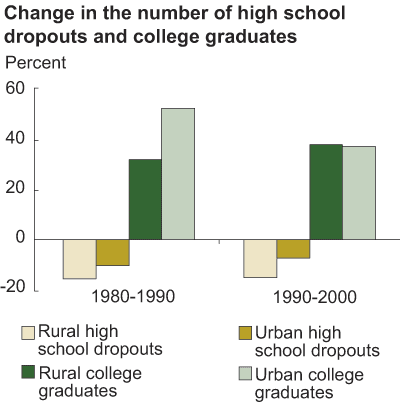Rural College Graduates Make a Comeback
- by Robert Gibbs
- 9/1/2003
The movement of better educated adults from rural areas to urban areas has a longstanding history in America. Data from the 2000 Census, however, show a departure from this trend, as rural areas held their own in the 1990s by attracting and keeping college graduates to work and raise families. In the 1980s, the number of college graduates grew about two-thirds faster in America’s central cities and suburbs than in rural areas, but in the 1990s, rural and urban counties enjoyed similar rates of increase.
At the same time that rural America experienced robust growth in college graduates, the number of rural high school dropouts fell. As recently as 1980, there were six high school dropouts for every two college graduates in rural areas; by 2000, the ratio had improved to three to two. At the current rate of change, college-educated adults will outnumber high school dropouts in rural areas within a decade, and may reorient widespread perceptions about workforce skill levels in rural versus urban areas.
Can we soon expect a plethora of college graduates in every corner of rural America? No, the recent turnaround—the substantial growth in the college-educated population—was not evenly distributed across rural areas. In high-poverty areas in the rural South and Southwest, low-wage resource-based and manufacturing economies limit the kind of high-skill job growth that attracts college graduates. The rural Mountain West, on the other hand, experienced a 50-percent gain in college graduates, in large part because graduates’ greater income and wealth and wider job market networks enable them to settle more easily in highly desirable areas, such as those rich in natural amenities.
It is probably too soon to tell whether the rapid increase in rural college graduates in the 1990s is the beginning of a long-term narrowing of the rural-urban gap in human resources. Other ERS research found that rural population growth, particularly from college graduates, was much higher during the first half of the 1990s. And, many rural areas will continue to fall short in attracting highly educated workers. The recent improvement in rural educational attainment, nonetheless, is good news in an economy increasingly geared toward high-skill production.
This article is drawn from:
- Employment & Education. (n.d.). U.S. Department of Agriculture, Economic Research Service.


